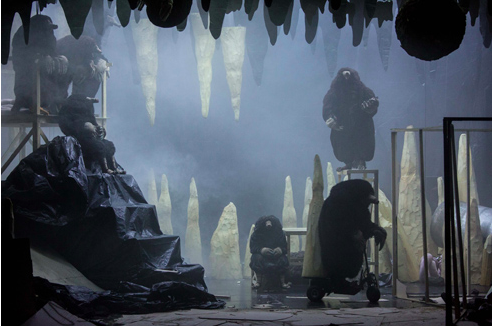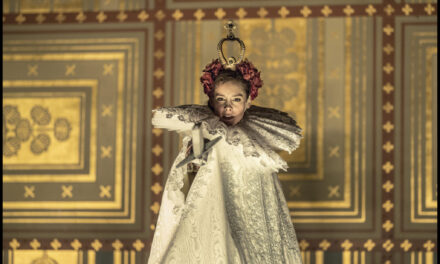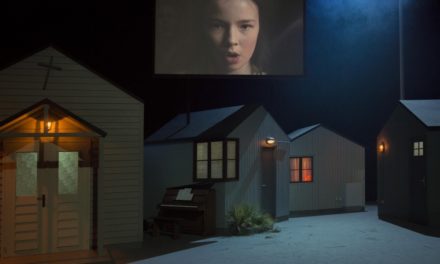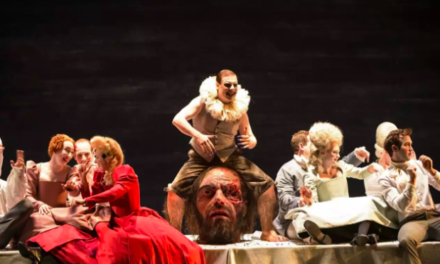Heidi Wiley: With the creation of ETC, its founders wanted to establish a new form for international collaboration and artistic exchange between European theatres.
Recently, Ukrainian theatrical space has begun a slow, but irreversible depressurization. Despite all the complexities and inertia of the post-Soviet system of organizing theatrical affairs, our theater moves slowly towards integration into the European theatrical process and revealing itself on the international artistic map. One of the markers of integration processes in the theater was the presence of network theater organizations that began to show interest in our local affairs, even lobby for theatrical reforms in accordance with the standards of theatrical systems in democratic societies. The most active player in this field was the European Theatrical Convention (ETC). With Heidi Wiley the head of the convention, we talked about the mission of the organization and the vision of the Ukrainian context from a European perspective.
When and for what purpose was the European Theatre Convention established?
The European Theatre Convention (ETC) was founded in 1988 by three theatres from Belgium, France, and Germany with the aim to exchange performances and also staff members with each other. With the creation of ETC, its founders wanted to establish a new form for international collaboration and artistic exchange between European theatres. This was still a time before the Iron Curtain fell before the European Union became an active player to support cultural exchange and dialogue between its member states. But it was also a time in the late 80’s when a lot of international cultural initiatives were born, due to the strong desire of people to connect and exchange with each other across borders.
Tell us about the program “Ukraine in Focus?” Why has Ukraine become interesting for European people?
During and after the Maidan revolution in 2014, international attention was on Ukraine. Within our network, we also discussed the ongoing revolutionary upheavals that happened on the edge of Europe. All of a sudden, this country that was never on the theatrical landscape of major European theaters became of interest and we also wanted to find out who are the artists, the theatrical and cultural institutions and what are their voices, their situations to deal with the current developments. With the support of the German Federal Office, we were able to initiate our program “Ukraine in Focus.” It started off in 2014 inviting a delegation of Ukrainian theatre directors and young theatre artists to our international theatre conference at the German State Theatre Braunschweig. During this first encounter the idea of organizing a Ukrainian theatre showcase was born, in order to not only talk about Ukrainian theatre but also to see the work of our colleagues and bring an international group of theatre professionals to Ukraine. Alongside this idea, we also believed in the need to support young artists from Ukraine in offering working opportunities in European theaters to discover new artistic and socio-cultural perspectives and to create new professional contacts. In 2015 both the Ukrainian theatre showcase in Kiev and the first year of our scholarship program for young artists took place. Since then, in 2016 and 2017 we emphasized our efforts to engage with the young generation of artists and developed multilateral scholarship programs for Ukrainians and European artists to work together. Our new program “Theatre is Dialogue – Dialogue of Cultures. European Networking with Eastern European Theatres” offers just that – an artist residency program during the Gogolfest in Kiev, scholarship placements in various European theaters and placements for Ukrainian artists at the Georgian theatre showcase and its masterclasses as well as participation in ETC’s European Theatre Academy for international collaboration during the Festival d’Avignon. Next, to our artistic programs we also support and accompany the structural development of the independent Ukrainian theatre scene. With our Ukrainian member theatres and our program alumn, a reflection group was initiated in 2016 to formulate reform recommendations in a cultural-political dialogue with Ukrainian stakeholders and hence engage in a public democratic debate within the space of theatre.
Which of the Ukrainian theaters are members of the ETC?
So far, there were three theaters members of the ETC. The Kiev Academic Molodiy Theatre Kiev, Cultural Art Center Dahk and New Theatre on Pechersk.
What opportunities open the Ukrainian theatre’s membership in the ETC?
ETC membership offers all its theatre members international networking and an international community, access to ETC artistic and professional activities and programs, participation in our international conferences that take place twice per year and most importantly personal and trustful relations between partners on eye level and international collaboration opportunities.
Do you watch some dynamics in the Ukrainian theatrical process? What trends are obvious to you?
From our talks with Ukrainian colleagues, and also most recent presentations of Ukrainian theatre at the German festival Heidelberger Stückemarkt in May 2017, it seems that there is a strong dynamic movement of documentary and experimental theatre, using forms of very direct storytelling to deal with the current political and most recent developments including the war on the Eastern border and the Krim occupation. A young generation of theatre-makers strives in order to bring their stories on stage, without any financial support, but looking for ways of self-organization and in reaching out to foreign cultural institutions. One example I would like to mention was the production End Of Imitations 2.0 by Dima Lewinsky and directed by Pavel Yurov, a documentary theatre play about some of ETC’s alumni working in European theaters and their experiences being part of another system, not just in the West, but in highly organized – and hierarchical – theatre structures. Journeys about the growing up of young people and finding their place in our very complex societies. A production that was made possible with the aid of Goethe-Institue Ukraine and the belief of its director to give the young independent theatre-makers the necessary means to express their voices.
What problems of the Ukrainian theater, in your opinion, are the most important for us?
The theatre is always a very local and intimate way to express a subject between a group of artists and a group of audience. The choices of the subject and their relevance to the lives of the audience members, as well as the way the story is told and performed, are two main decisions that are to be made when talking about the relevance of contemporary theatre and its positioning as part of the cultural public offer. The current challenges Ukrainian theatre faces are those related to the famous three “P” – who are the people making which type of program for what public? Questions that are to be dealt with in any cultural organization and also to be stipulated in cultural policies on a local and national level, not just in the Ukraine. The transformation process in Ukraine is still ongoing, and political decisions to nourish a lively contemporary theatre for both the publicly funded sector and the independent scene are crucial preconditions to help to provide perspectives for this art form on the local and international level.
What problems are now in the focus of the German theater?
Debates in German theatre shift as regularly as there are new artistic trends and production modes appearing. Nevertheless, one strong topic that does not vanish is the role and the concept of the so-called “Stadttheater.” Most cities have one, there are over 140 in the entire country, often it consists of several branches including drama, opera, ballet, concert, and youth theatre. Depending on its legal structure it is co-financed by the federal ministries and communal authorities. The program is made based on the repertory system and all institutions employ their permanent ensemble of actors and musicians. Actually, this is one of the strong backbones of the German public theatre systems. What can be currently observed is that new directors have been appointed, e.g. Matthias Lilienthal at the Münchener Kammerspiele or very lately Chris Dercon at the Berliner Volksbühne, who transform traditionally well known and highly reputed repertory theaters in taking different interdisciplinary artistic choices and associate with artists from the independent scene, who bring their own actors and in consequence no longer maintain the ensemble nor repertory character of the theatre. What are the artistic profiles of those houses compared to free producing houses or festivals who bring cultural offers only during a limited period of time? Questions of categoric artistic choices and its diversity, performances vs productions, combined with available financial resources and structures, and the purpose of public space inviting to engage in artistic debate and reflection through contemporary theatre are current major topics that are discussed.
Can an independent artist become a member of the convention or just an organization?
ETC membership is open for producing public theaters and festivals with a strong commitment to promote and create contemporary theatre, an associated membership is also possible for other cultural organizations wishing to join and support the objectives of ETC. However, an independent artist can’t become a member. One major reason for this is to allow members to collaborate based on similar structures and similar conditions – which are already as you can imagine in more than 20 countries largely diverse. Our members are both repertory system based theatres employing their own ensembles of actors and producing and hosting theaters working with independent companies.
In Germany, the theater is very actively supported by the state. Does the state have any requirements and restrictions for supported projects?
As per constitution the freedom of expression and the arts are guaranteed without censorship. Therefore the state is not in a position to restrict any supported projects. Often supported projects, if they are subject to individual funding, must meet however certain funding priorities that were predefined in order to serve the purpose of the specific funding goals. The general support by the state for theatre as part of the public cultural offer is also established as part of the federal cultural constitutional policies.
On what principle is the non-state sector of theater financed? Are there state support programs for the independent theater sector?
Access to finances for non-state theatre organizations or independent artists is possible through various funding schemes and mostly made available through a financial mix of resources. Often on federal or communal level organizations receive a temporary funding based on applications or framework contracts, the same can apply for independent artists. In addition, the project based funding has become for many independent organizations and artists a crucial way to realize specific work, either through funds from cultural foundations or other grant systems from private or public sources. The question of sustainability and longevity of those financing systems and the relevance and quality of independent artistic works versus those from the state-funded sector give nevertheless also always a reason for ongoing debates.
This post originally appeared in Ukrainian Theatre on October 23, 2017, and has been reposted with permission.
This post was written by the author in their personal capacity.The opinions expressed in this article are the author’s own and do not reflect the view of The Theatre Times, their staff or collaborators.
This post was written by The Theatre Times.
The views expressed here belong to the author and do not necessarily reflect our views and opinions.


















